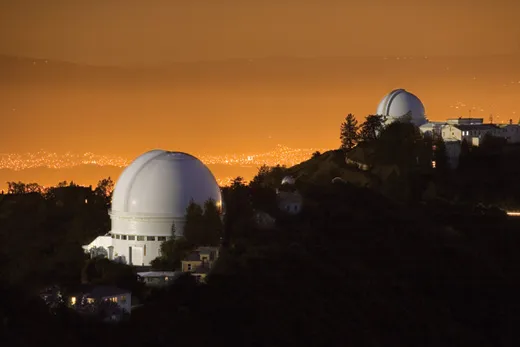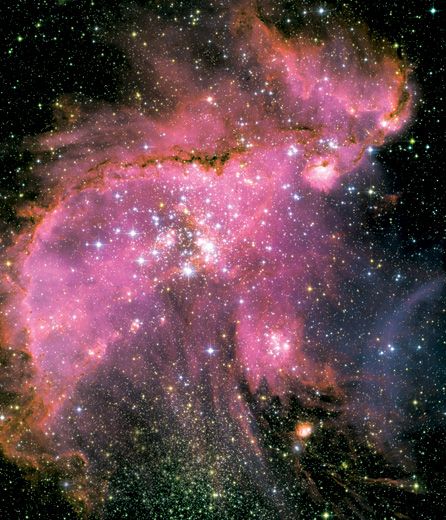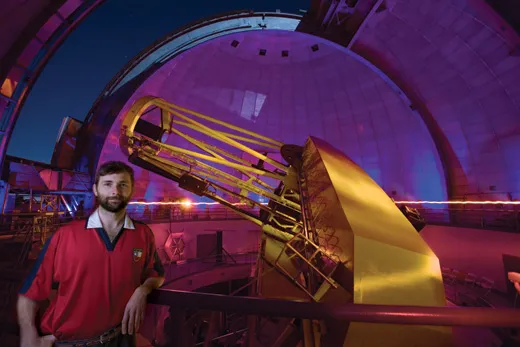The Planet Hunters
Astronomers have found about 200 planets orbiting other stars, and they say it’s only a matter of time before they discover another Earth
It's a challenging night for astronomy at Lick Observatory near San Jose, California. The lights of Silicon Valley shimmer below the 4,200-foot summit of Mount Hamilton, washing out the faintest stars. Clouds drift closer from the north with a threat of rain. On the mountaintop are ten telescope domes, and I walk up a steep driveway to the biggest one. There's an eerie sound, like a loose shutter groaning in the wind. It's the dome itself, creaking as it rotates to keep its opening centered above the slowly moving telescope inside.
Chris McCarthy, an astronomer at San Francisco State University (SFSU), greets me at a side door. Wearing a small light strapped to his head, he leads me up metal stairways through the dome's interior, kept inky dark for nighttime observations, and into the warm control room. There, Howard Isaacson, an SFSU senior, and Keith Baker, a telescope technician, sit at computer screens amid thick bundles of cables and racks of antiquated electronics. McCarthy and Isaacson chat and sip hot tea while Baker uses his computer mouse to adjust the telescope. Before dawn, the astronomers will gather light from dozens of stars. Some of the stars, they hope, harbor new worlds.
In an era of rovers exploring Mars and space-based telescopes taking dazzling pictures of the cosmos from above the murk of Earth's atmosphere, the routine at Lick—pointing a 47-year-old telescope at star after star for hours on end—feels rather quaint. Yet these astronomers are members of a team that is the best in the planet-hunting business. Using telescopes in Hawaii, Chile and Australia, as well as those at the Lick Observatory, to monitor about 2,000 stars—most of them quiet and middle-aged like our sun and close enough to Earth for big telescopes to get a clear view of their movements—the team has found about two-thirds of the 200 or so planets discovered outside our solar system so far. (The recent hubbub about how to define a planet in our solar system hasn't threatened the planetary status of these distant objects.)
Some of the newfound extrasolar planets, or exoplanets, as they are called, are giant worlds the size of Jupiter that circle their stars on tight, roasting orbits, far closer than Mercury's orbit around the sun. Others swoop close to their stars and then swing far out on egg-shaped paths, scattering smaller bodies as they go. Some newborn planets fling their sibling planets to a fiery doom or into the depths of space.
Nowhere to be seen—at least not yet—is a solar system like ours, with solid planets near the sun and gas-giant planets on orderly processions farther out. Such a system is the likeliest place for a rocky planet like Earth to survive in a stable orbit for billions of years. Perhaps it's parochial, but astronomers seeking signs of life elsewhere in the cosmos—a quest that animates the search for exoplanets—are looking for planets and solar systems rather like ours, with a planet that is neither too far from nor too close to a star, and perhaps with water on its surface. The California team says finding Earth-like planets is just a matter of time.
The study of exoplanets is still very new, after all. Earlier than a decade ago, astronomers figured it would be impossible to see them against the brilliant glare of their stars. So a few astronomers tried to find exoplanets by looking for stars that seemed to wobble, tugged by the gravity of unseen bodies orbiting around them. But most experts doubted the approach would work. "People thought looking for planets was worthless," McCarthy says. "It was one step above the search for extraterrestrial intelligence, and that was one step above being abducted by aliens. Now, it's one of the greatest scientific advances of the 20th century."
The first exoplanet, discovered in 1995 by Michel Mayor and Didier Queloz of the University of Geneva, in Switzerland, was a giant object half the size of Jupiter, whirling around a star similar to our sun in a frenzied orbit every four days. The star, in the constellation Pegasus, is about 50 light-years away. More "hot Jupiters," or giant gaseous planets orbiting close to stars, quickly surfaced, if only because those big bodies impose the most pronounced wobbles on their parent stars.
Though astronomers haven't observed those planets directly, they infer that they're gaseous from their sheer size and what’s known about planet formation. A planet coalesces out of the debris in the great disks of dust and gas surrounding stars. If it reaches a certain size—10 to 15 times the size of Earth—it exerts such a gravitational pull and sucks in so much gas that it becomes a gas giant.
As measuring techniques improved, astronomers discerned gradually smaller planets—first the size of Saturn, then down to Neptune and Uranus. After a few years of spotting exoplanets, scientists saw a promising trend: as the sizes they could detect got smaller, there were more and more of them. The process that builds planets seems to favor the little ones, not the titans.
In the last year and a half, the California team and a group led by researchers in Paris discovered the smallest exoplanets yet seen around sunlike stars: the two planets were just five to eight times the mass of Earth. Astronomers say such worlds may consist mostly of metal and rock, perhaps with thick atmospheres. The exoplanet found by astronomer Geoff Marcy of the University of California at Berkeley and colleagues is close to its star and probably too hot for liquid to exist on its surface. The other planet orbits far from a faint star and may be as cold as Pluto. Still, learning that not all exoplanets are giant balls of gas was a landmark for the field. "These are the first plausibly rocky worlds," says Marcy. "For the first time, we are beginning to discover our planetary kin among the stars."
The most surprising feature of exoplanets so far, Marcy says one day in his office on the Berkeley campus, is their unusual orbits. In the classic "overhead view" diagram of our solar system, the planets (except for oddball Pluto, recently demoted to a dwarf planet) trace nifty concentric circles around the sun. Marcy reaches behind his neat desk and takes out an orrery, a mechanical model of our solar system. Metal balls at the ends of spindly arms swivel around the sun. "We all expected to see these phonograph-groove circular orbits," Marcy says. "That's what the textbooks said about planetary systems. So when we first started seeing eccentric orbits in 1996, people said they can't be planets. But they turned out to be a harbinger of things to come."
Just after midnight at the Lick Observatory, the astronomers are making good progress on the night's checklist of 40 stars. Their targets usually aren't the major stars of the constellations, but, even so, many are bright enough to see with the naked eye. "When I'm out with my friends, I can point to a couple of stars that we know have planets," Howard Isaacson says. One particularly bright star in the Andromeda constellation has three.
McCarthy offers to reveal the secret of the team's success at spying exoplanets. We walk into the dark dome and pass under the telescope, with its ten-foot-wide mirror that collects and focuses the faint rays of light from distant stars. I had seen the massive telescope during daytime tours, but at night it looks much more vital, its thick metal struts angled like the legs of a tall praying mantis looking up at the heavens. McCarthy leads me to a cramped room beneath the dome's floor, where starlight concentrated by the telescope's mirror is streaming into a cylinder smaller than a soda can. It's wrapped in blue foam, with glass on both ends. It looks empty inside, but I'm told it's full of iodine gas heated to 122 degrees Fahrenheit.
This iodine cell was developed by Marcy and his former student Paul Butler, now an astronomer at the Carnegie Institution in Washington, D.C. When light from a star passes through the hot gas, iodine molecules absorb certain wavelengths of light. The remaining light is spread out into a rainbow by an instrument that acts like a prism. Because the iodine has subtracted bits of light, dark lines are scattered across the spectrum like a long supermarket bar code. Each star carries its own signature of wavelengths of light that have been absorbed by the star's atmosphere. These wavelengths shift slightly when a star moves toward or away from us. The astronomers compare the star's own signature of dark lines with the stable iodine lines from one night to the next, and from month to month and year to year. Because there are so many fine lines, it's possible to detect even minute shifts. "It's like holding the star up to a piece of graph paper," McCarthy says. "The iodine lines never move. So if the star moves, we use the iodine lines as a ruler against which to measure that motion."
For something as big as a star, the only things that can cause a regular, repeating shift are the gravitational tugs of another star—which astronomers could detect easily because of a companion star's own light signature and its hefty mass—or a hidden planet orbiting around it. The iodine cell can track a star moving as slowly as several feet per second—human walking speed—across the vast emptiness of trillions of miles of space. This sensitivity is why many planet-hunting teams use the iodine cell.
I peer inside it and see some crinkled foil and heating wires snaking through the blue foam. Strips of duct tape appear to hold parts of it together. After we return to the control room, McCarthy chuckles and points out the slogan on Keith Baker's sweat shirt: "When the going gets tough, the tough use duct tape."
The more oddly shaped and oddly spaced orbits that astronomers find, the more they realize that the natural process of planet formation invites chaos and disorder. "It became clear that our solar system, with its beautiful dynamics and architecture, was much more stable than those around other stars," says theoretical astrophysicist Greg Laughlin of the University of California at Santa Cruz, who collaborates with Marcy and Butler's team. Trying to figure out how new planets acquired their weird paths has been a daunting task. Laughlin designs computer models of exoplanet orbits to try to re-create the planets' histories and predict their fates. He focuses on the role of gravity in wreaking havoc. For instance, when a big planet moves on an eccentric orbit, its gravity can act like a slingshot and fling smaller nearby worlds. "In some of these systems," Laughlin says, "if you insert an Earth-like planet in a habitable orbit, it can literally be ejected within weeks."
Interactions among planets may be common in the cosmos, Laughlin and his colleagues say. Almost 20 stars are known to have more than one planet orbiting around them, and some of these sibling exoplanets are locked into a dance called a "resonance." For instance, one planet circling a star called Gliese 876 takes 30 days to orbit, while another planet takes almost exactly twice as long. Laughlin's calculations show that their mutual gravitational pull preserves a stable, clocklike arrangement between the two planets.
Resonances are strong clues that the planets migrated far from their birthplaces. The disk of dust and gas that spawns embryonic planets has a gravity of its own. The disk drags on the planets, gradually pulling them inward toward the star or, in some cases, forcing them outward. As this migration goes on for hundreds of thousands of years, some exoplanets become trapped in resonances with their neighbors. When big planets end up in close quarters, they whip each other around and create some of the eccentric orbits seen by the team. At least, that's the current best guess.
Other planets are not long for this world. Laughlin's computer models suggest that some of the planets closest to their stars will plunge into them as more distant planets bully their way into smaller orbits, perhaps in a matter of hundreds of thousands of years. This research into distant solar systems has raised a fascinating scenario about our own solar system. Some astronomers theorize that Venus, Earth and Mars are "second-generation" planets, successors to earlier bodies that were born closer to the sun and migrated inward until they were consumed.
Does all the observed chaos in the universe portend dire consequences for small rocky planets? Not at all, Laughlin says. The technique of measuring the back-and-forth wobbles of stars, sensitive as it is, would have to be about ten times finer to reveal objects the size of Earth. But satellite telescopes scheduled for launch in the next few years might be able to detect "shadows" of alien earths as the small planets pass in front of their stars. Laughlin predicts the satellites will find such bodies in droves, even around stars where no large planets have yet been seen. "It's very likely that [sun-like] stars are accompanied by terrestrial planets," he says. "My intuitive sense is that our solar system is not uncommon at all."
Berkeley's Geoff Marcy agrees, because he says every star is born with enough raw material around it to create many planets. Lots of solid planets like Earth should form, he says, as dust coalesces into pebbles, which collide again and again to make asteroids and moons and planets. "Maybe Jupiters are rare," he says, "but rocky planets almost certainly are common. I just don't see how making an Earth could be hard."
The small exoplanet recently detected by Marcy and Butler's team supports that view. They found it while monitoring the two resonant planets in the Gliese 876 system, which is 15 light-years away. Something was exerting subtle extra tugs on the planets' orbits, and the best explanation for that is a third planet perhaps 7.5 times as massive as Earth. Given its size, the planet is likely rocky, like Earth, rather than a gas giant. The discovery was a major step toward answering the question on everyone's mind: Can we find potential habitats for life elsewhere?
Astronomers were hoping that question would be answered by a NASA satellite mission called Terrestrial Planet Finder. It was supposed to go beyond detecting exoplanets: it would take images of the most tantalizing exoplanets and analyze their atmospheres. But early this year, NASA put the mission on hold, largely because of budget overruns from the space station and the space shuttle and the expected cost of the plan to send people to Mars.
In the meantime, the California-based team keeps looking for more exoplanets. In a few months, Marcy and co-worker Debra Fischer of SFSU will start working with a new telescope at Lick called the Automated Planet Finder that will feature the most sensitive light-analyzing instrument yet made for exoplanet searches. The robotic instrument will scan about 25 promising stars every clear night, with the potential to detect planets as small as three to five times bigger than Earth. "This will be the world's first telescope completely dedicated to planet hunting," Fischer says. "People thought it would take billion-dollar space missions to find other planets like Earth, but I think we have a shot at it from the ground."
Marcy says finding planets from earth is just the beginning. "Ultimately, we need to go, with robotic spacecraft and a small digital camera, and send that little puppy to Tau Ceti or Epsilon Eridani," Marcy says, naming two nearby stars with particular promise for hosting Earth-like planets. They are 12 and 10.5 light-years away, respectively. "Sure it will take 100 years [to develop the technology], but it is a wonderful goal for our species, and it is within our grasp. It is entirely technologically feasible to get the first pictures of the surface of a planet around another star. We can launch a global mission, an emissary from Earth. The effort we're doing now is simply reconnaissance for that mission, but it is a glorious reconnaissance to spot the first oases in the cosmic desert."
Robert Irion directs the Science Communication Program at the University of California at Santa Cruz. Photographer Peter Menzel co-authored Hungry Planet: What the World Eats.



